 |
Bolivia - Pure nature and culture!

Holiday in Latin America - most of the people think on dreamy endless beaches and tanned beach beauties in Brazil or at the carnival in Rio. Thus, those who like to do some beach holidays and bath in the sea will not have a dream holiday in Bolivia, as this country is located amidst South America and surrounded by Chile, Peru and Brazil and does not have one single beach section.
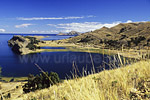
But therefore, Bolivia can be a dream destination specially for nature and culture lovers with its sightseeings of the extra class. Specially around the secret capital la Paz, there are some places for excursion on a relatively small space (relatively small space under consideration the country is three times bigger than Germany, thus approximatley 200 kilometres) for which one would need between one and two weeks.
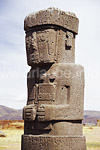
Starting from some jungle tours in the Amazon basin with a unique flora and fauna to the endless wideness of the Bolivian highlands and the Titicaca Lake up to the sky-rising ice giants of the Cordillera Real, this will make the heart of the nature lovers beat faster. But also the travellers who are interested in culture will find plenty of sightseeings. Gorgeous colonial buildings, relicts from cultures more than 2000 years old, legends and myths, and the traditional life of the country population enable a deep insight into the eventful history of Bolivia; And also those who like to move on foot can do a lot of half- or full day hiking tours or even, capability provided, to climb from La Paz an easy 6000 m peak, always accompanied by the views to a fascinating landscape.
The sightseeings and excursion destinations described in the following pages in and around La Paz are a part of the cultural and mountain climbers journeys in which I took part in the year 2004.
Regional studies
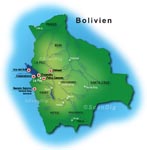
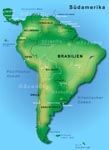
But what kind of country is Bolivia at all? How big is it, how many inhabitants does it have, where exactly is it located and how does the country nature look like? The republic Bolivia is located quite in the middle of South America, approximately between the 10. and the 25. southern latitude and is surrounded by five Neighbour states that are Brazil at the north and the east, Paraguay, Argentina and Chile in the south, and Peru in the west. Despite of a surface that is three times bigger than Germany, approximately 1,1 million square metres, only approximately 8 million people live in the Andine state, a thing that equals to a population density of 7,3 people per each square kilometre, which means 30x less than in Germany! Half of the population is concentrated in the cities and by this way, there are parts of the country that are almost deserted, as for example the areas of the tropical rain forest in the Amazon basin. And therewith, we already talk about the natural subdivision of Bolivia. The north and the east is marked by the Bolivian lowlands that consist on three parts, the tropical rain forest of Amazon, the swamp of the Pantanal and the spiny bushvelds and dry forests of Gran Choco.
Adjacent to this in the southeast, there are at a height of 1000 up to 3600m the so-called Yungas, these are mountains and cloud forests with some deeply cut valleys and canyons. Due to the humidity rising from the lowlands and raining down the mountain slopes, there is a bright vegetation, thereunder many mosses, lichens, orchids, bromelias and chinchona barks and rubber trees.
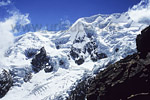
The lowlands and the Yungas are approximately two thirds of the country surface, the rest is taken by the Bolivian Andes that are subdivided into the west and east cordilleras and rise up to more than 6500m over the sea. Between these two mountain chains there are, at a height between 3600 and 4000m, the forest-free and steppe-like highlands of the Altiplano that has an expansion of 200 times 700km and is considered as the core landscape of Bolivia together with the Titicaca Lake. Additionally, there are countless salt pans and salt lakes in the south of the Atiplano with some huge flamingo colonies, therunder the Salar de Uyuni as the most known salt lake.
Bolivia has a tropical climate whereby the different altitude areas dominate the temperature and the rainfalls. By this way, it happens that in the humind and hot lowlands, specially in the rain forest, there are rainfalls throughout the year. The further one gets to the south-east, the drier the climate gets. The main rainy season is during the southern spring and summer time, these are the months from October up to March. The temperatures only have a low seasonal change so that even during the winter one can wear a t-shirt in La Paz on a warm day.
Population, economy and politics
As a part of the old Inca empire, two thirds of the population of Bolivia consist on indigenas (quechua and aymara), 25 per cent are mestizos (hybrids) and only 8 per cent criollos, thus purely ethnic Spanish. More than 80 per cent of the population is roman-catholic, whereby being christians does not stop many indigenas to practice additionally also some nature religions or to believe in creation myths and shamanism.
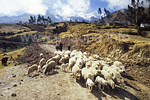
Specially the high rate of analphabets amongst the adults is a shame (almost 40%!) and the bad provision of clean potable water and medical services, specially in the rural areas.
Bolivia is considered as the poorest country of Latin America, a thing that is also reflected in the GDP of 2400 dollars per capita and year. Approximately two thirds of the population have one dollar per day for a living, although the country has the biggest natural gas reservoirs of South America and is very rich in natural resources. One reason for the poverty is surely the exploitation of the natural resouces for centuries under the inhuman conditions by the Spaniards in the past, and in the present time, the mining of silver, gold, zinc, bleed and copper are handled by foreign corporations so that the money does not end in the local population but abroad.
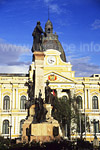
40 per cent of the economical active population is active in the agriculture and the cattle breeding that is mainly operated on substancial basis, thus is more or less self supporting. 10 per cent work in the industry, trade and in the service sector and the rest, thus half of the economicaly active people are either unemployed or underemployed...
The presidential Republic of Bolivia was founded on August 6th, 1825 by Simon Bolivar and currently consists on nine departamentos with a total of 94 provinces and 1272 circles. The president is the governments' head at the same time and is voted for five years. The national Congress (Congreso Nacional) acts as the countries' representation, a bicameral parliament consisting on a house of representatives and a senate. As during the history of Bolivia there were more than 200 violent changeovers of power, it seldom occured that a president was in power during his full tenure! The capital is certainly Sucre, but all the system commerce is done from the parliament house in La Paz. The meaning of each of the three national colours red-yellow-green is still to be mentioned; Red stands for the bloodshed of the numerous Wars, yellow for the power of the sun and green for the ground's fertility.

Back to the index Bolivia
Author: Flori Forster; Copyright: Patrick Wagner, www.tourist-guide.biz
|
 |